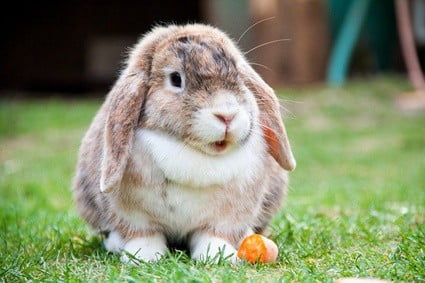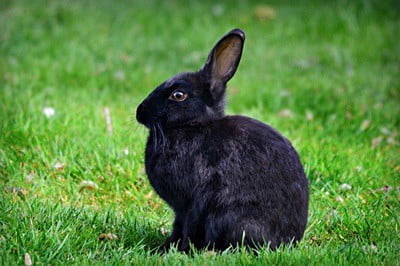You may have noticed that your bunny’s ears move in a variety of ways. Whether drooping, twitching, or up and alert, they’re rarely stationary. Instead, your rabbit’s ears cycle through a variety of positions. Animal body language can be subtle, so you may wonder if these angles have meaning.
The position of a rabbit’s ears says a lot about how it’s feeling. Ears that are almost touching mean a relaxed rabbit. Ears that are up and erect mean that a rabbit is alert to noises and sounds. If your rabbit’s ears are flattened, this means that it’s scared. Ears that are held back mean an angry rabbit.
With that said, a rabbit’s ear positions can vary depending on the breed. Lop-eared rabbits have heavier ears and, therefore, subtler ways of showing emotion. Illness can also impact the way your rabbit moves its ears. A sudden change in its default ear position may indicate infection or heat stroke.
How Rabbits Use Their Ears
To understand what rabbit ear positions mean, we need to understand how rabbits use their ears. After all, it’s a kind of body language. With insight into how the ears work, we can better understand the subtle messages our pets are sending. Rabbits use their ears in two main ways:
Functionally
Rabbits have a great sense of hearing because of the shape and size of their ears. The long and pointed design allows them to capture sounds with ease. Likewise, their ears cover a large area (relative to their body size). This allows rabbits to hear across great distances.
To leverage this sense of hearing, rabbits twist their ears into different positions. That helps them to closely tune into a sound, much like radar. With ears like these, rabbits can detect noise from miles away. That is, so long as they choose the right position. For observant owners, this can be a window to how they are feeling.

Emotionally
A rabbit has great hearing. Because of this, you’ll see a difference when it feels unsafe or is looking for danger. It may flick its ears more insistently to find the location of the danger. Likewise, when it’s curious about a sound, or wants to find something to play with, the body language of its ears will change accordingly.
This tells us the rabbit’s state of mind. The ears will indicate what the rabbit is looking for, how it feels about its surroundings, and even what it thinks of you.
Beyond that, rabbits can use their ears to convey more subtle emotions. Rabbits communicate with fellow rabbits and human owners through movements and gestures.
Rabbit Ear Position Meanings
Owners should note the subtle cues given off by their rabbit’s ears. Here are some of the most common rabbit ear positions, and what each one means:
Upwards, Pointing Outwards
What if your rabbit’s ears are closer together and pointing outwards? Then you have a relaxed and happy bun. If you see this often, then you’re doing a great job of taking care of it. Your rabbit feels safe and pleased.
A happy bunny will also have a relaxed posture throughout the rest of its body. This pose can appear differently based on your rabbit’s subtle feelings.
Loaf
Your rabbit can be in a loaf position. Its legs are tucked under its body, and its eyes are probably closed or partially closed. This is the bunny version of lounging. This means it’s calm enough to let down its guard and chill out.
Extended
If your rabbit is very relaxed, it may take on an extended position. Its paws will be stretched out, pointing forward. Its hind legs may be sticking out sideways. Alternatively, its legs could be stretched out behind it, further adding to its body length.
In this position, your rabbit probably won’t be keen on playtime. It means that your rabbit is tired and would like to rest. It won’t mind pets as it regains its energy, but may grow upset if disturbed.
Up And Twitching – Alert or Piqued
If your rabbit’s ears are up and twitching, this means it’s alert. Twitching ears indicate that something has piqued your rabbit’s interest. It is honing in on a noise and listening intently.
If the ears stay upright the entire time, then it has located the sound and is trying to glean the finer details. If the ears rest down after a moment, the rabbit might have decided the sound was unimportant.
This reaction could be entirely for your rabbit’s benefit. However, the bunny could also be trying to alert you or other animals to the sound. Wild rabbits often live in colonies. It’s natural to warn others of a potential danger. If the rabbit’s ears continue to twitch while laid down, then it may be encouraging you to listen too.
One Ear Up, One Down – Half Attention
If your rabbit has one ear up and one ear down, that means that it is, quite literally, only half listening. Rabbits are always on the lookout for interesting sounds and noises. However, some sounds are just less interesting than others.
If your rabbit has one ear up and one ear down, that’s the case. This ear position is called the “half-lop,” where only one ear is up.
That means your rabbit is listening, but the noise isn’t worth its full attention. Perhaps it doesn’t think of the noise as a potential danger. The sound could be something it’s used to. It could also be so faint that your rabbit doesn’t think it’s dangerous yet.
When your rabbit has one ear up and one ear down, it may still pay attention to you. However, that’s only if you’re more interesting than the sound it’s listening to.
Wide Apart And Flattened – Fear
If your rabbit’s ears are wide apart and flat against its back, you have a scared rabbit. Rabbits flatten their ears to make themselves smaller. After all, being smaller means being harder for predators to spot or catch. When something spooks your rabbit, it will try to shrink out of instinct. Tucking away its large ears can make a significant difference in size.
Aside from its ears, the rest of your rabbit’s body can signal if it’s afraid. It will likely be crouching, with its head flat to the ground. Its muscles will be tense, and it will probably try to remain still. Other signs of fear include:
- Shaking
- Running away
- Hiding
If your rabbit is scared, keep an eye on it, as it may injure itself. With prolonged exposure to stress and anxiety, it can even die of fright.
If you think your rabbit is spooked, determine the cause. Try to stop the source of its fright or remove your bunny from the situation. Common reasons for frightened rabbits are:
- Loud noises
- Unfamiliar smells
- Other people
It may also help to calm down your rabbit with cuddles and snacks.
Ears Held Against Back – Displeased Or Angry
What if your rabbit’s ears are in an upward position, but held slightly to its back? This means that your rabbit is unhappy. The behavior indicates it wants to be left alone, or that you should back off. You may earn this response after picking up, petting, or holding the bunny.
Otherwise, your rabbit may dislike you being near its territory. If you touched its belongings, this position can be firm rabbit-speak for “stop that.” It could feel protective of its food bowl, cage, or toys. In these cases, it’s best to back off and try again when your rabbit has calmed down.
This behavior is often accompanied by grunting. Grunting is the main way to signal displeasure, alongside thumping. If grunts, thumps, and its accompanying body language is ignored, this can be bad news. Disregarding these signs often results in scratching or even biting.
If your rabbit is sitting up on its back legs, with its front paws raised, this is the boxing position. When that happens, be wary! It signals that your rabbit has shifted from being defensive to being wholeheartedly aggressive. There are things you can do to prevent this behavior. This includes:
- Desensitization: You get your rabbit used to things that upset it.
- Socialization: You get your rabbit used to being handled.
- Spaying and neutering: Shown to lessen aggression in rabbits.
- Exercise: Provides a healthier way to spend its energy.
Default Ear Positions
A rabbit’s ear positions can clearly indicate emotion. However, not all rabbit ears are built the same. Some ears are naturally more erect, while others are not. You may think your rabbit is constantly alert, when, in fact, that’s just the bunny’s normal resting position.
As such, it’s important to know the different ways a rabbit’s ears are built. This can help you gain a more accurate read on your bunny. Here are some default ear positions, and what they mean for your rabbit’s body language:
Erect
This is the most common type of ear position. Rabbits often have naturally erect ears by default. This allows them to absorb the most amount of sound and react quickly to their surroundings.
Lop Ears
Lop ears refer to ears that are droopy by default. When the rabbit hops, its ears often bounce alongside it as well. Lop breeds, like their name implies, will brandish this feature. Their ears are often in this position because they are thicker, longer, or both. According to Genetics, lop breeds owe their droopy ears to a mutated gene.
This gene results in ears that are almost double the size of the usual rabbit. The droopiness comes at a downside, however. Lop rabbits are more at risk of developing issues with their hearing and teeth, according to Vet Record.
What does this mean for your rabbit’s body language? You’ll have to watch more closely to read cues on these ears. Both erect and lop-eared rabbits share the same meanings for the same ear positions. However, that may be subtle or partly masked by the extra droopiness of heavy, flopping ears.
Lop-eared rabbits also struggle to make their ears fully upright. The shape of their ears makes it harder for them to notice noises. There is less for them to listen to. Because of this, lop-eared rabbits will often have their ears at rest, drooping downwards on the side of their heads.
With that in mind, remember: their ears may hang much lower when they’re “alert.” Likewise, an angry bunny’s laid-back ears will remain more flush with their spine.

Half Lop Ears
Like its name implies, half lop rabbits only have one ear erect, while the other droops downwards. This ear may be fully drooping, or almost fully drooping. Some rabbit ears may even form a diagonal line. Keep this in mind when checking for the “half attention” body language.
Oar Lop Ears
Proper lop ears droop to the ground. However, they can also droop halfway. When this happens, you get a rabbit with oar lop ears. These ears will rest just above the rabbit’s shoulders, resembling oars on the side of a boat.
Oar lop ears are often held slightly backwards, but they can be almost completely horizontal. Because of that, you may have heard of this position in another name: helicopter ears. With ears completely on a rabbit’s sides, your bun can look like it’s about to take flight.
With this breed, understand that laying the ears flush against their back is more difficult. You’ll need to watch for the rest of their body language to determine anger or happiness. However, if you know your rabbit well, it’s possible to note the subtle shift of the ears into those prominent positions.
Horn Lop Ears
On some very rare occasions, a rabbit’s ears may not droop to the side. Instead, it may droop forwards.
Like oar lop ears, horn lop ears are horizontal to the ground. Unlike oar ears, however, horn lop ears hover above the rabbit’s nose instead of its shoulders. This may resemble horns.
Younger Rabbit Ears
A rabbit’s genes will determine if it has lop ears. Aside from genetics, age plays a role. Baby rabbits less than 9 to 13 days old cannot keep their ears erect.
So, if you’re worried about a baby rabbit’s ears, you needn’t be. It simply lacks the ability to raise them. It can’t tell you if it’s happy, at rest, or angry yet. In the following weeks, it’ll develop more control over its body. At that point, the baby rabbit can properly share emotions.
Rabbit Ears That Are Suddenly Droopy
As mentioned, some rabbit breeds have ears that naturally droop to one side. However, if one or both of your rabbit’s ears have suddenly drooped, this can be concerning.
Infection
A suddenly drooping ear is typically a sign of infection. Specifically, your rabbit’s inner ear may be unwell. To treat infections, your rabbit must be prescribed antibiotics by your vet.
Infection will cause droopy ears because of how it affects the muscles. If the rabbit is in pain, it will often lack the energy to make its ears stand erect. Alternatively, moving the ears could be painful for your rabbit.
Aside from drooped ears, your rabbit’s body language can help you determine if it has an infection. Bunnies with ear infections will often hop around in circles and have their head slightly tilted. Other symptoms include:
- Loss of appetite
- Smelly discharge from the ear
- Irritability
If you notice any of these symptoms in your rabbit, it’s best to make an appointment with your vet.
Overheating
If your rabbit is a Flemish Giant, a drooping ear can be due to heat. Rabbits and heat don’t mix well in general. However, because of their size, Flemish Giants are more prone to heatstroke. Aside from droopy ears, a Flemish Giant that’s too hot will also have red ears. For any breed of rabbit, symptoms of heatstroke include:
- Shallow breathing
- Drooping ears
- Sluggish movements
- Having a convulsion
If your rabbit shows any of these signs, make sure to give it first aid.
- Move it to a cool, shaded area
- Place it in front of a fan
- Give it cool water to drink
Understanding rabbit ear positions can help you better connect with your rabbit. From anger to happiness to caution to interest, a rabbit’s emotions show in its ears. Even more importantly, watching the ear positions can help you spot illnesses that may be plaguing your bunny.
Keep these little cues in mind. With them, you can correct behavior, provide relief, or feel pride at properly caring for your bun.

